Mockingbirds and Thrashers of Maricopa County
Northern Mockingbird Mimus polyglottos
This well known bird is common and widespread in North America in the Lower 48. True to it's name, the Northern Mockingbird is an impressive mocker. It imitates the songs of endless other birds, as well as other animals and a variety of other sounds. This awesome songster commonly sings at night also. Birders could keep a "life list" of the birds and other sounds the Northern Mockingbird imitates. Northern Mockingbirds are found in a variety of habitats in their range, which are mainly open areas such as fields, lawns, suburban areas, deserts, etc. They have a diet of a variety of foods, most commonly being fruits and insects. Mockingbirds are also very defensive and aggressive of their nest, and relentlessly defend the nest against any intruders. Intruders include other birds, cats, and even people. Northern Mockingbirds are permanent residents in Arizona and throughout most of their range. In Maricopa County, they are easily found in the city in parks, neighborhoods, and lawns. This species has adapted to live close to people. They are easily found in natural habitats too, such as open fields, deserts, and open foothills.
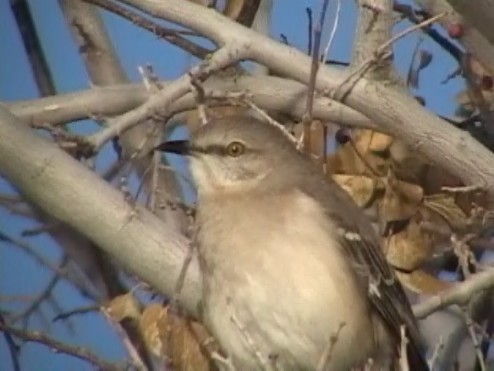
Sage Thrasher Orescoptes montanus
In sagebrush of western North America, the well named Sage Thrasher makes it's home. This small thrasher spends most of it's time on the ground, although males commonly perch on elevated perches to sing a pleasing song. Sage Thrashers feed highly on insects as they are seen running on the ground, and they also feed on fruit. This bird is often very shy and harder to approach. Breeding Sage Thrashers find Arizona in the northeastern part of the state where there is good sage habitat. They are also very migratory, and migrate south to winter in the southwestern United States and Mexico. Their wintering grounds consist of open desert in lower elevations as well as hills covered in junipers in medium elevations. In Maricopa County, they are found from late fall through all of winter and into early spring. Perhaps the best time to see numbers of them is in March, when most of the population migrates north. The Thrasher Spot at Baseline Road/Salome Highway (Area 8) is often a spectacular place to see Sage Thrashers in abundance during spring migration. Sage Thrashers are reliable in Maricopa County during winter in several locations. Open deserts throughout the county are good places to look, as well as chaparral and juniper covered hills. Due to juniper berries, Sage Thrashers winter in areas of medium elevations to feed on those berries where there are junipers. Throughout all of winter and in the migrations, good places to look for Sage Thrashers in Maricopa are: Area 1 (Sunflower, Bushnell Tanks, Lower Mount Ord, Four Peaks, Slate Creek Divide), Area 2 (Coon Bluff Recreation Site), Area 4 (perhaps Red Mountain Park), Area 6 (Phoenix Mountains Preserve), Area 8 (Thrasher Spot at Baseline Road/Salome Highway), Area 11 (Lower Camp Creek, Mount Humboldt Road, Seven Springs Recreation Area) and Area 12 (perhaps the road to Horseshoe Lake in chaparral habitats).
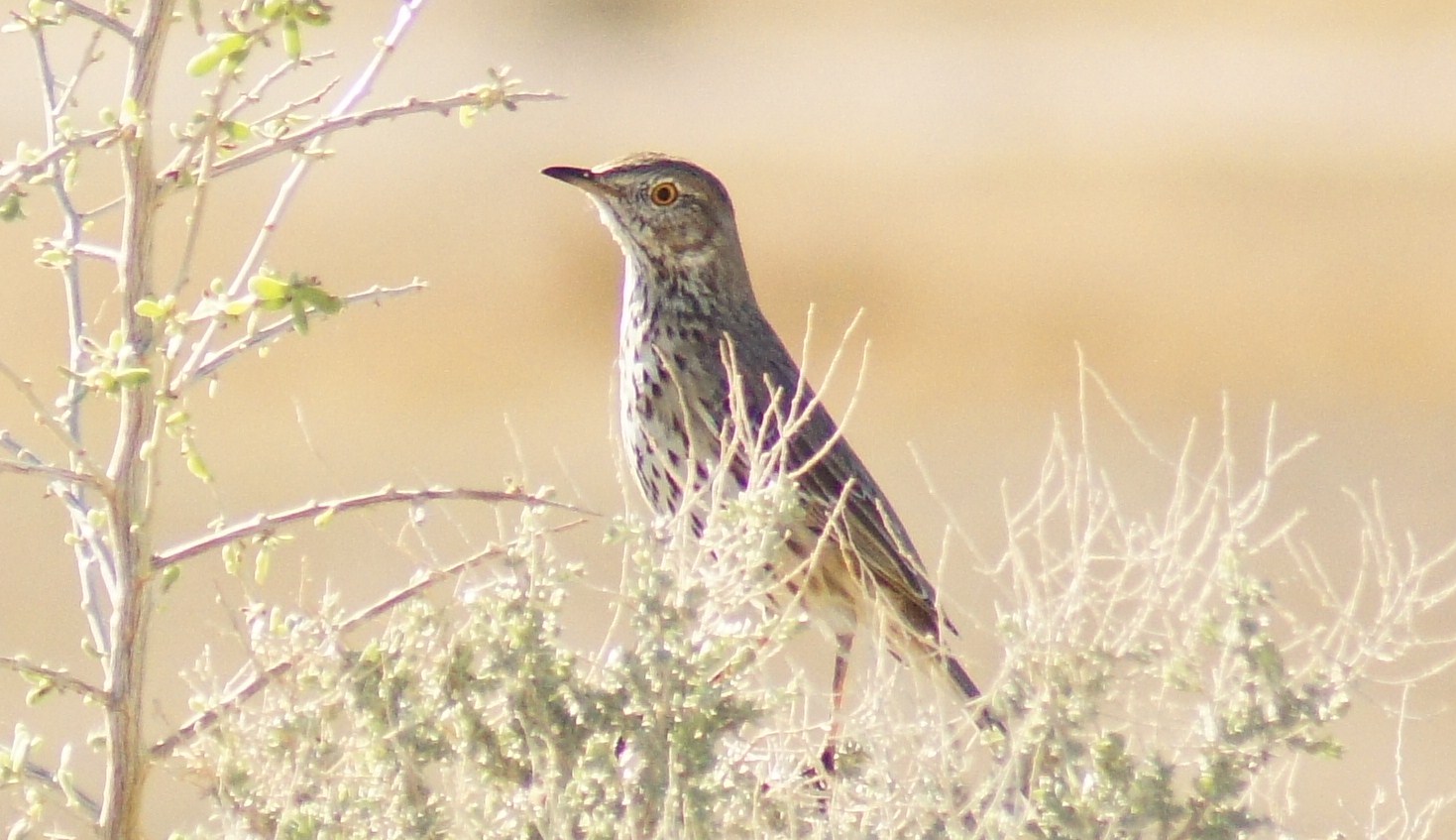
Bendire's Thrasher Toxostoma bendirei
The Bendire's Thrasher looks like a smaller version of the much more common and larger Curve-billed Thrasher. Rather shy and retiring, the Bendire's Thrasher spends most of it's time on the ground, where it feeds mostly on insects but also on fruit taken from a cactus. Males commonly sing in the open on perches, who's song is rather distinctive for a thrasher (most sound extremely similar). Bendire's Thrashers are found in the southwestern United States, and Arizona is the by far the best state to observe this species. Maricopa County is a very good area to see Bendire's Thrashers year round, who's favored habiat consists of open saltbush and creosote desert with lines of mesquite trees throughout the desert. Searching habitat with this combination offers a better chance to find this bird, but several spots in the county are good and are very reliable. The Thrasher Spot at Baseline Road/Salome Highway (Area 8) is probably the best place in Maricopa County to view the Bendire's. Besides that spot, other open desert in Area 8 with mesquite trees are often good for seeing the Bendire's Thrasher as well. Another good location to view them at is on the east side of the county in Mesa's Red Mountain Park (Area 4). This park has good habitat in and around the park limits, where Bendire's Thrashers are regularly observed.
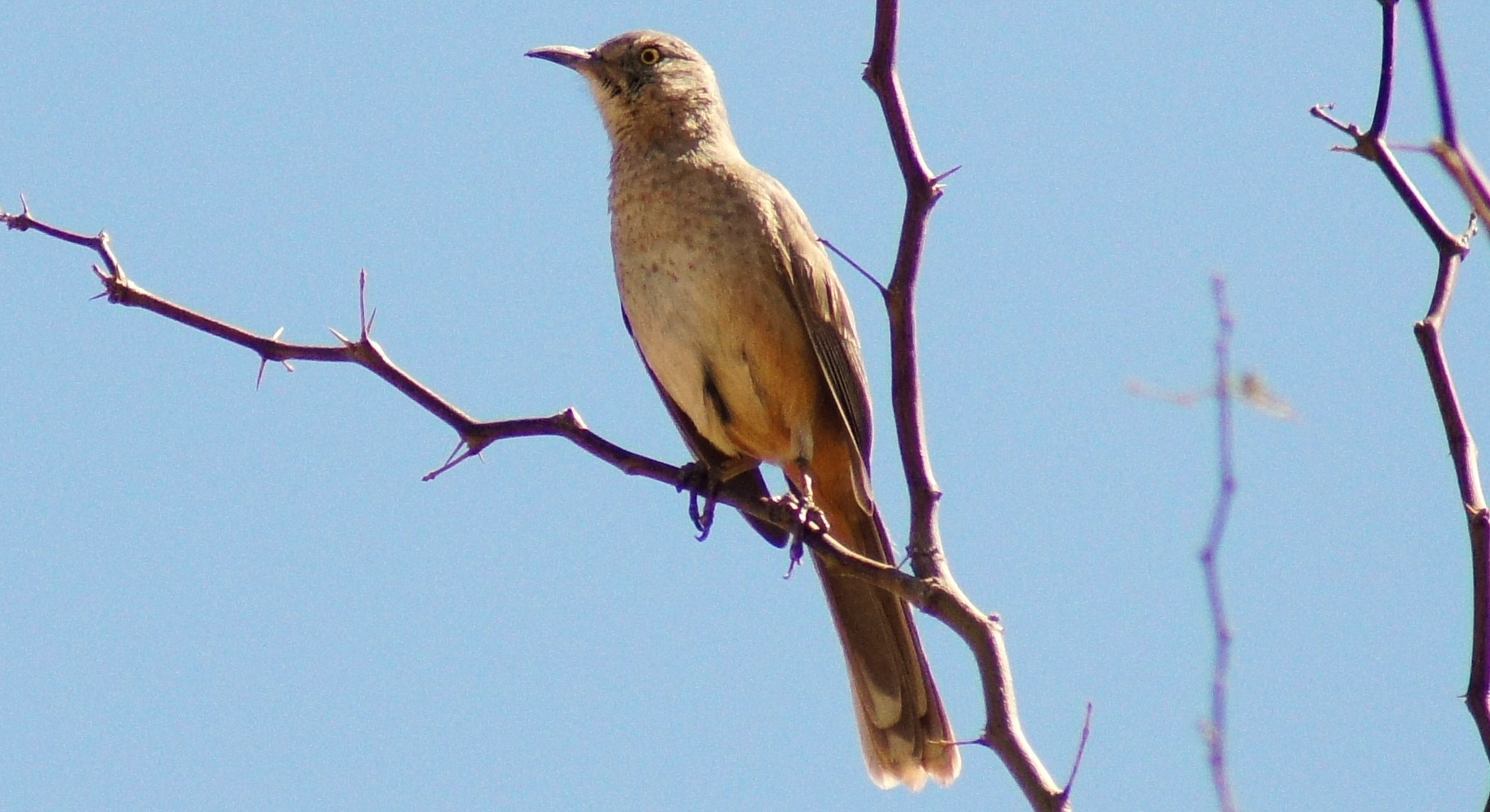
Curve-billed Thrasher Toxostoma curvirostre
The "whit-wheet whit-wheet" call of the Curve-billed Thasher fills the deserts of the southwest highly in Arizona, New Mexico, and Texas. Both notes of this common distinctive call are high, but the second syllable is much higher. The Curve-billed Thrasher is our most common thrasher in Arizona, and is easily found in deserts, riparian areas in midst of deserts, and in residential areas, parks, and yards. Curve-billed Thrashers aren't shy like that of other thrashers, and are very noisy and viewable in open situation. This bird forages with it's bill facing the ground, as it picks insects off the ground with it's large bill. It also eats a variety of other foods that also include fruit. In Maricopa County, the Curve-billed Thrasher is very common and is found in almost any area. Any deserts with cactus, riparian habitat in midst of deserts, and residential areas are great for viewing these birds, which are year round residents wherever they range.
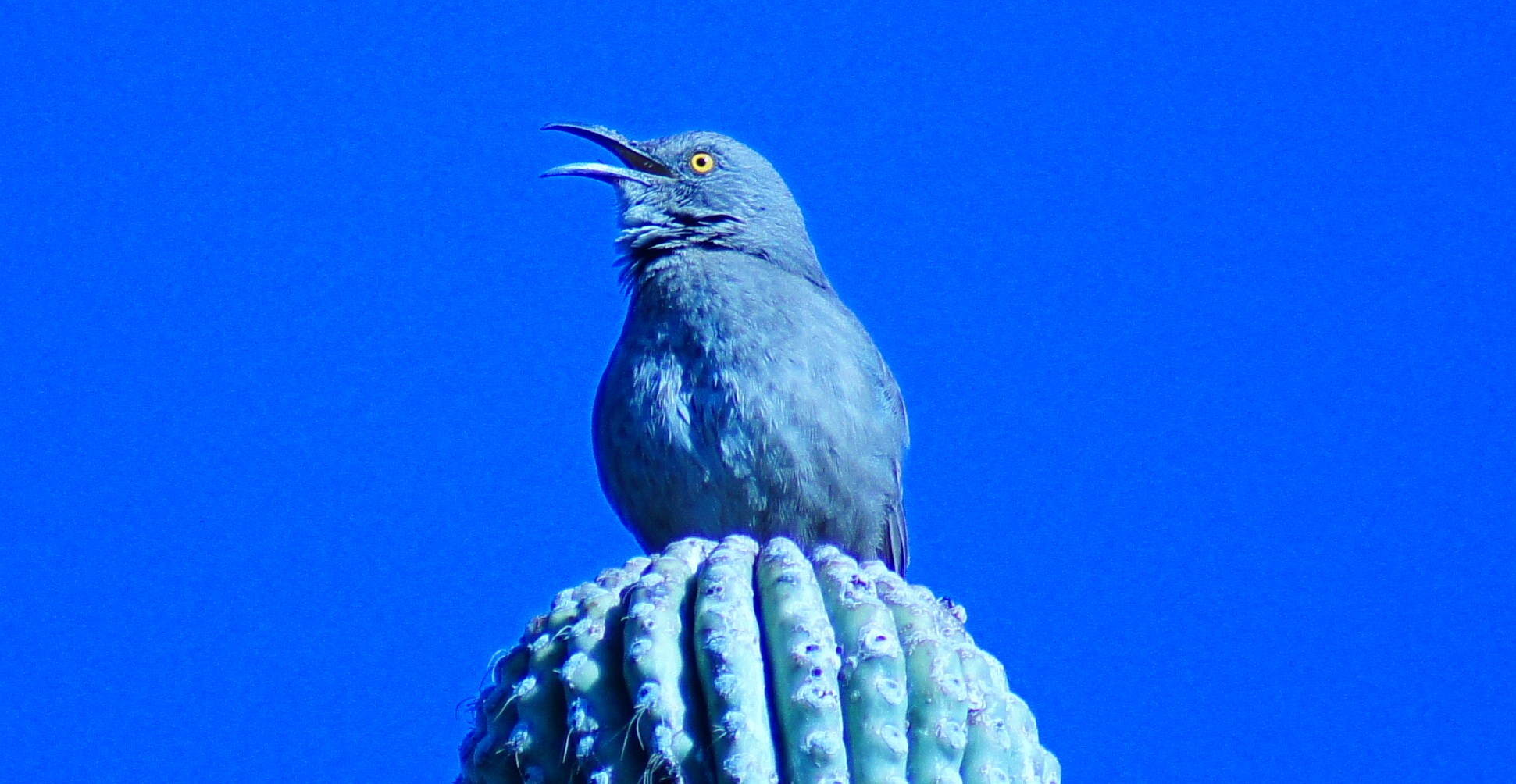
Crissal Thrasher Toxostoma crissale
This large thrasher is found in the deserts and dry foothills of the southwest, where it is very shy and elusive, rarely coming into open view. Crissal Thrashers run on the ground through dense cover, and don't stick around long if alarmed. Male Crissal Thrashers do sing in the open at times on perches, which is the best time to view this bird. It has a very cool look and appearance to it, with an extremely long and decurved bill, giving it a fierce look. Like other thrashers, Crissal Thrashers feed on the ground, where it's diet consists of insects, spiders, small reptiles, and fruit. When walking through Crissal Thrasher habitat, walking quietly and listening for foraging birds on the ground holds a better chance of getting good views of the bird. The Crissal Thrasher's song sounds similar to the songs of other thrashers, but it's rolling "chi-deery chi-deery" call is very distinctive and is often heard, making it easier to locate a bird. In Arizona and the southwest where the Crissal Thrasher makes it's home, it is found in a variety of dense habitats with varied elevations. This habitat consists of deserts, which one sequence is desert dominated by open salt bush that has dense mesquite thickets in midst of the open desert in washes. The Thrasher Spot (Area 8) is a great example of this. They also favor riparian woodlands domintated by thick brush, thickets, and understory, often with good mesquite habitat nearby. Tres Rios Wetlands-Hayfield Site (Area 7) and Granite Reef Recreation Site (Area 2) are good examples of where Crissal Thrashers may also be found. Another good habitat that Crissal Thrashers highly favor are chaparral covered slopes in Upper Sonoran Zones that range in elevation from 4-6000'. Lower Mount Ord is a great example of this (Area 1). Throughout Maricopa County, Crissal Thrashers are found a year round basis where they are nonmigratory. They are the easiest to view in January and February as they start to breed, as the males are up and singing, making them much easier to view. Areas that are good in Maricopa County for Crissal Thrashers are: Area 1 (chaparral covered slopes of lower Mount Ord, Slate Creek Divide, and Four Peaks Wilderness), Area 2 (Granite Reef Recreation Site, Foxtail/Sheeps Crossing Stretch), Area 3 (probably chaparral habitat along Fish Creek), Area 7 (Tres Rios Wetlands-Hayfield Site, Baseline and Meridian Wildlife Area), Area 8 (Thrasher Spot at Baseline Road/Salome Highway, dense vegetation and mesquite chains along the Old US 80), Area 10 (Morgan City Wash, Hassayampa River Preserve), Area 11 (Mount Humboldt), and Area 12 (probably the different habitats along the Horseshoe Lake Recreation Area).
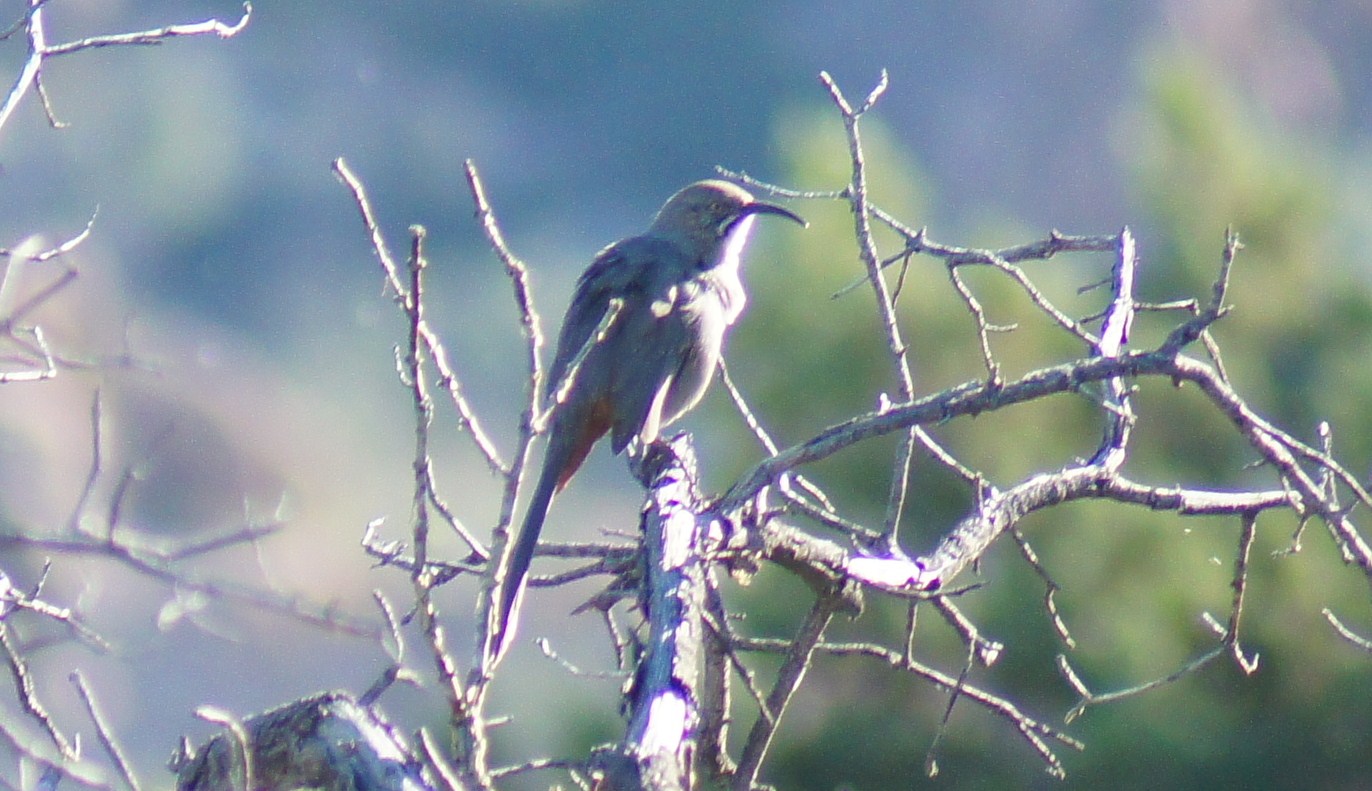
Le Conte's Thrasher Toxostoma lecontei
The pale-colored, elusive and shy Le Conte's Thrasher may be observed year round and is very local in Maricopa County and the southwest. Le Conte's Thrashers are a very popular species and are highly sought out by many traveling birders coming to Maricopa County every year, who thrive to get a look at this shy bird. The Thrasher Spot in the southwest part of the county (Area 8) is the best place in the United States to view this unique and hard to find species. It should be found on most visits by walking around with patience. They are more easily observed in January and February as they begin nesting, and the males are more likely to be up singing. They prefer the more open desert where saltbush are dominant. A good strategy would be to walk around in these habitats until a thrasher is seen or heard, which can take anywhere from a few minutes to a few hours. They are usually seen first as a glimpse as they sprint on the ground at a fast speed with their tails held high, as they will pause briefly before continuing to run on the ground. The Le Conte's Thrasher covers a good distance and will disappear just as fast as they are located. Some birding outings may have to result in quick glimpses. They also like to perch on a bush or tree at a medium heighth (often in the middle or on top) if there are saltbush nearby. Often when spooked, the Le Conte's will run and jump up briefly to a branch of a higher than ground level perch to look for what spooked them, before returning back into the ground cover. They also have a soft and high-pitched call which helps locate them, which sounds a little similar in tone to a Phainopepla, but much dryer and lower. Le Conte's Thrashers feed on the ground on insects, berries, and cactus fruits. In Maricopa County, the main reliable place to see the Le Conte's Thasher is the world famous Thrasher Spot at the Baseline Road and Salome Highway intersection (Area 8). Le Conte's Thrashers are year round residents in their range, and are a very sensitive species. When walking through the thrasher spot, this bird's nest is sometimes ran across, where the adult thrashers make it rather obvious there is a nest nearby. Be sure to keep a good distance and respect the nesting area by backing away. Thrashers are also very sensitive and responsive to tapes, DO NOT play tapes at the Thrasher site to call in Le Conte's Thrashers. In Area 8, there are some other areas away from the Thrasher Spot with appropriate habitat they may hold a Le Conte's Thrasher, but the Thrasher Spot is by far the best location. If your up for a fun challenge, go look for this awesome bird!
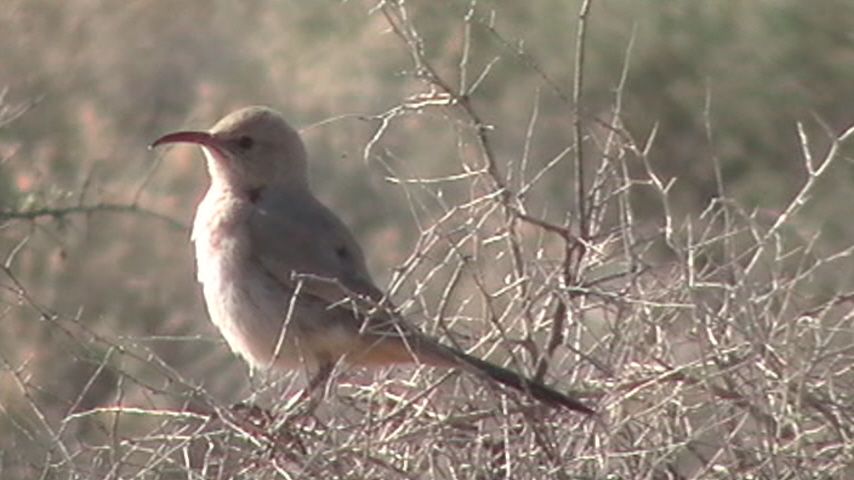
Back to What Bird Are You After? main page. |
